International Marketing Project: Starbucks' Failure in Australia
VerifiedAdded on 2022/11/27
|18
|3807
|412
Project
AI Summary
This project delves into the reasons behind Starbucks' failure in the Australian market. It begins with a brief overview of the company, followed by an analysis of its marketing strategy, vision statement, and the challenges of international expansion. The report highlights specific issues that contributed to Starbucks' struggles in Australia, including a lack of understanding of the local coffee culture and a failure to adapt its product offerings to local preferences. The analysis examines the sophisticated coffee culture of Australia, the growth strategy implemented, and the pricing strategies. The project further explores the reasons why Starbucks has struggled to establish a significant presence in Australia, including the strong competition from local cafes and the preference of Australians for espresso-based coffee. The project concludes with recommendations on how Starbucks could potentially achieve success in the Australian market, emphasizing the importance of market research, product adaptation, and strategic marketing approaches. This project is a valuable resource for students studying international marketing and entrepreneurship, offering insights into the complexities of global market entry and the importance of cultural sensitivity in business.
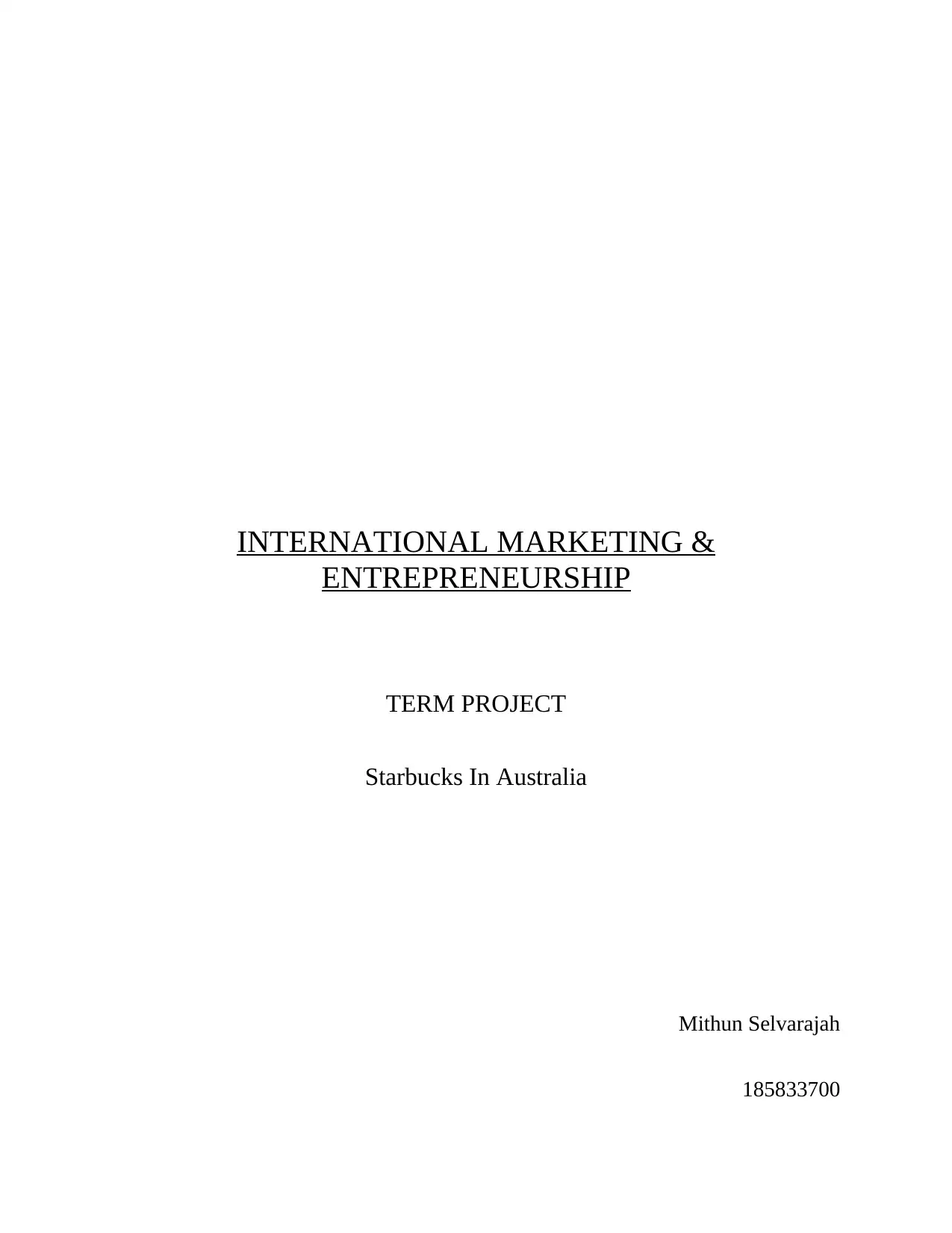
INTERNATIONAL MARKETING &
ENTREPRENEURSHIP
TERM PROJECT
Starbucks In Australia
Mithun Selvarajah
185833700
ENTREPRENEURSHIP
TERM PROJECT
Starbucks In Australia
Mithun Selvarajah
185833700
Paraphrase This Document
Need a fresh take? Get an instant paraphrase of this document with our AI Paraphraser
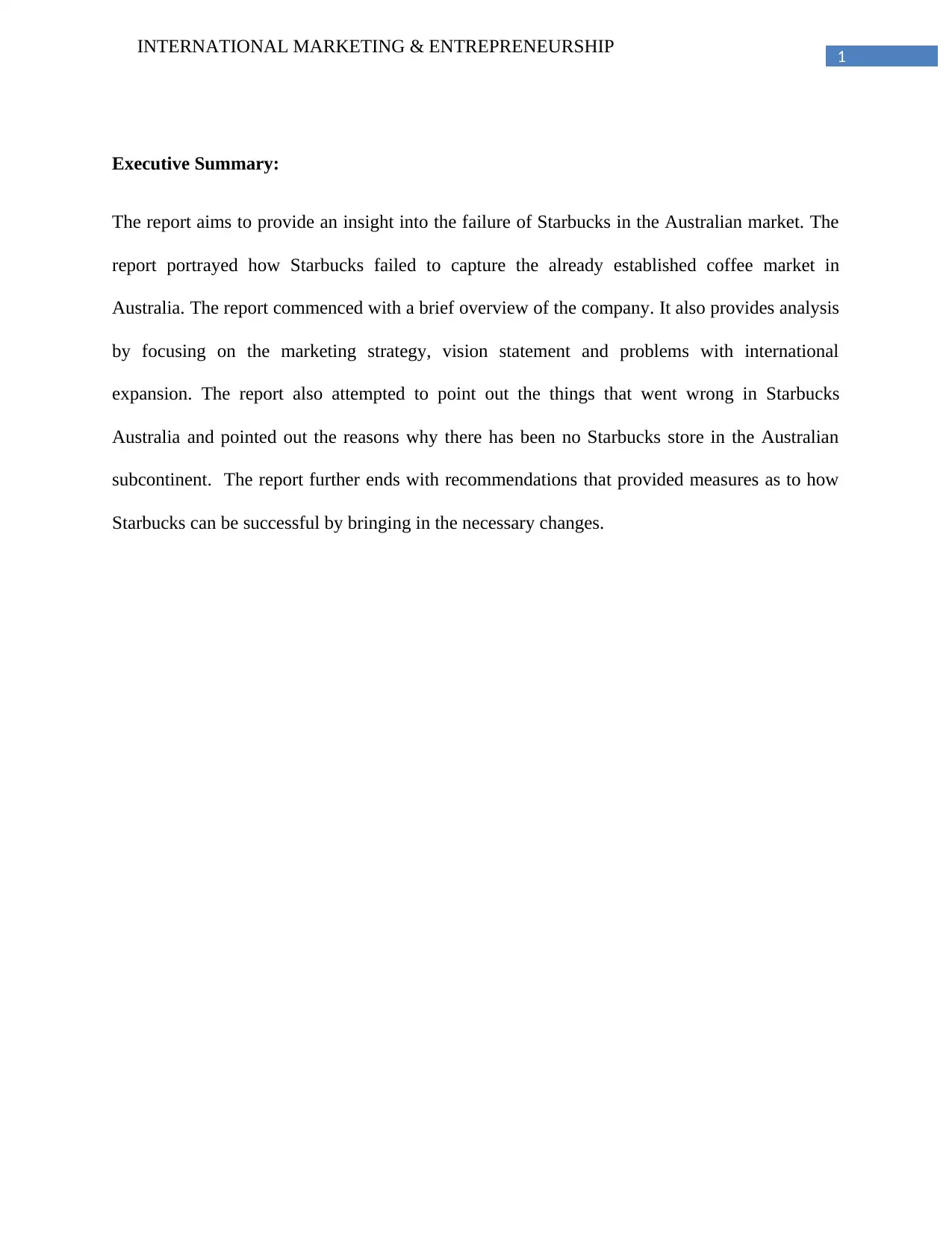
1
INTERNATIONAL MARKETING & ENTREPRENEURSHIP
Executive Summary:
The report aims to provide an insight into the failure of Starbucks in the Australian market. The
report portrayed how Starbucks failed to capture the already established coffee market in
Australia. The report commenced with a brief overview of the company. It also provides analysis
by focusing on the marketing strategy, vision statement and problems with international
expansion. The report also attempted to point out the things that went wrong in Starbucks
Australia and pointed out the reasons why there has been no Starbucks store in the Australian
subcontinent. The report further ends with recommendations that provided measures as to how
Starbucks can be successful by bringing in the necessary changes.
INTERNATIONAL MARKETING & ENTREPRENEURSHIP
Executive Summary:
The report aims to provide an insight into the failure of Starbucks in the Australian market. The
report portrayed how Starbucks failed to capture the already established coffee market in
Australia. The report commenced with a brief overview of the company. It also provides analysis
by focusing on the marketing strategy, vision statement and problems with international
expansion. The report also attempted to point out the things that went wrong in Starbucks
Australia and pointed out the reasons why there has been no Starbucks store in the Australian
subcontinent. The report further ends with recommendations that provided measures as to how
Starbucks can be successful by bringing in the necessary changes.

2
INTERNATIONAL MARKETING & ENTREPRENEURSHIP
Table of Contents
Introduction:....................................................................................................................................3
Brief Overview of the Company:....................................................................................................3
Analysis:..........................................................................................................................................4
Marketing Strategy of Starbucks:....................................................................................................4
Vision Statement of Starbucks:.......................................................................................................4
Problems of International Expansion:.............................................................................................5
Things that Went Wrong in Starbucks Australia:............................................................................5
Reasons for No Starbucks Store in Australia..................................................................................6
Recommendations:..........................................................................................................................9
Conclusion:....................................................................................................................................10
References:....................................................................................................................................12
INTERNATIONAL MARKETING & ENTREPRENEURSHIP
Table of Contents
Introduction:....................................................................................................................................3
Brief Overview of the Company:....................................................................................................3
Analysis:..........................................................................................................................................4
Marketing Strategy of Starbucks:....................................................................................................4
Vision Statement of Starbucks:.......................................................................................................4
Problems of International Expansion:.............................................................................................5
Things that Went Wrong in Starbucks Australia:............................................................................5
Reasons for No Starbucks Store in Australia..................................................................................6
Recommendations:..........................................................................................................................9
Conclusion:....................................................................................................................................10
References:....................................................................................................................................12
⊘ This is a preview!⊘
Do you want full access?
Subscribe today to unlock all pages.

Trusted by 1+ million students worldwide

3
INTERNATIONAL MARKETING & ENTREPRENEURSHIP
Introduction:
The report aims at providing a review on the failure of Starbucks in the Australian
market. Market failure represents a situation where the allocation of the goods and the services
are not effective (Weeden&Grusky, 2014). Market failures have been associated with non-
competitive markets, information asymmetries, externalities, problems of the principal-agent,
non-competitive market, public or externalities. As far as the Seattle based Starbucks
Corporation is concerned it had to undergo immense struggle in cracking the Australian market.
In the year July 2008, sixty-one stores closed down in Australia. It was in the year May 2014 that
Starbucks announced the ongoing losses in the Australian market that resulted in the stores being
sold out to Withers Group. The report provides a descriptive analysis of the failure of Starbucks
in the Australian market.
Brief Overview of the Company:
Starbucks Corporation has been a one-stop destination for coffee lovers. It ensures an
inviting atmosphere from day to day stress and acts as a comfortable and cozy place for meeting
the friends or enjoying me-time over a richly roasted and brewed cup of coffee. Starbucks is an
American company found in Washington in the year 1971 and has operations across 30,000
locations across the world (starbucks.com 2018). It is the sole representative of the ‘second wave
coffee’ that distinguishes it from the other coffee serving venue in terms of quality, taste and
customer experience. The locations of Starbucks primarily serve cold and hot coffees of different
varieties. Availability of the fresh juices, frappucino beverages, snacks and pastries including
INTERNATIONAL MARKETING & ENTREPRENEURSHIP
Introduction:
The report aims at providing a review on the failure of Starbucks in the Australian
market. Market failure represents a situation where the allocation of the goods and the services
are not effective (Weeden&Grusky, 2014). Market failures have been associated with non-
competitive markets, information asymmetries, externalities, problems of the principal-agent,
non-competitive market, public or externalities. As far as the Seattle based Starbucks
Corporation is concerned it had to undergo immense struggle in cracking the Australian market.
In the year July 2008, sixty-one stores closed down in Australia. It was in the year May 2014 that
Starbucks announced the ongoing losses in the Australian market that resulted in the stores being
sold out to Withers Group. The report provides a descriptive analysis of the failure of Starbucks
in the Australian market.
Brief Overview of the Company:
Starbucks Corporation has been a one-stop destination for coffee lovers. It ensures an
inviting atmosphere from day to day stress and acts as a comfortable and cozy place for meeting
the friends or enjoying me-time over a richly roasted and brewed cup of coffee. Starbucks is an
American company found in Washington in the year 1971 and has operations across 30,000
locations across the world (starbucks.com 2018). It is the sole representative of the ‘second wave
coffee’ that distinguishes it from the other coffee serving venue in terms of quality, taste and
customer experience. The locations of Starbucks primarily serve cold and hot coffees of different
varieties. Availability of the fresh juices, frappucino beverages, snacks and pastries including
Paraphrase This Document
Need a fresh take? Get an instant paraphrase of this document with our AI Paraphraser
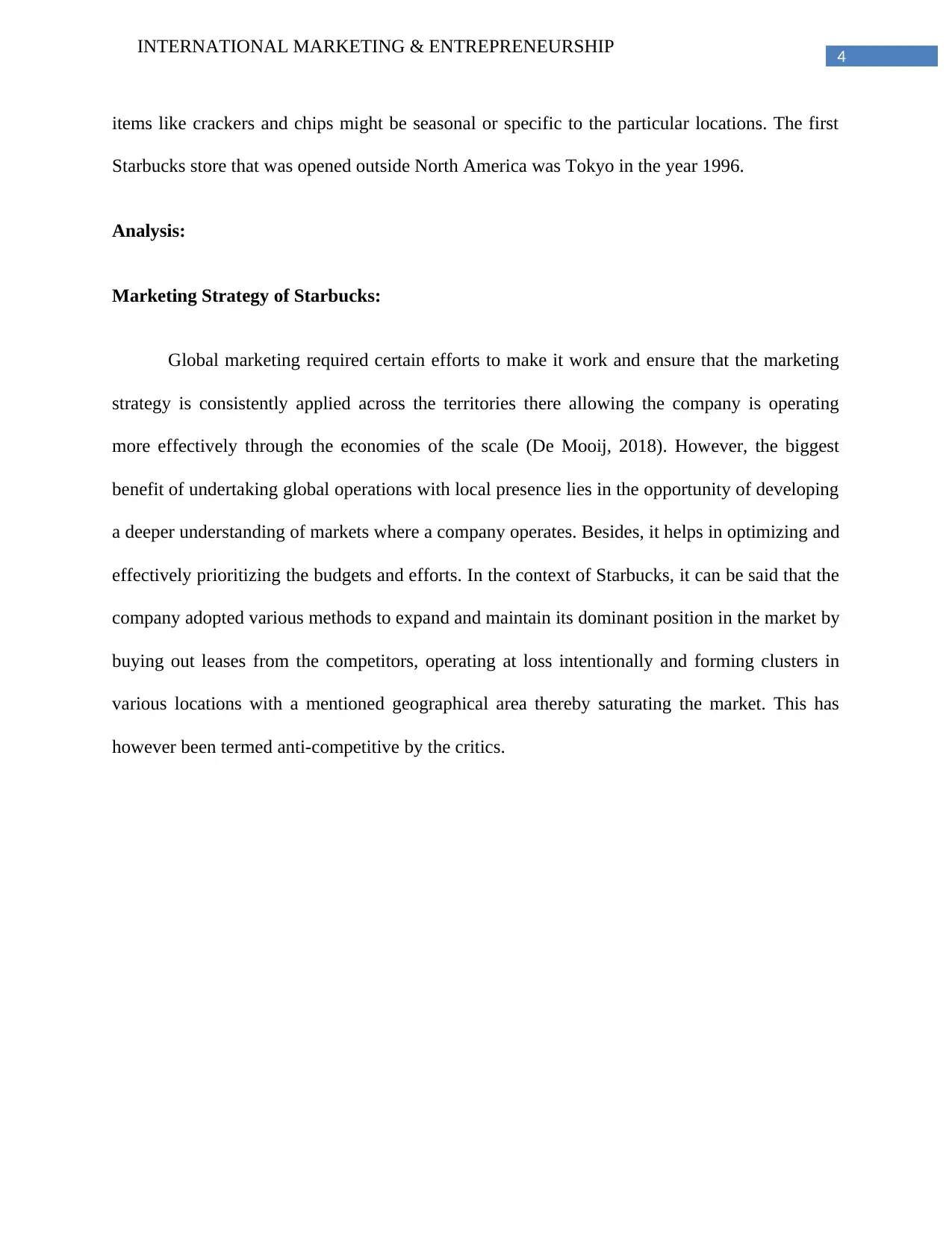
4
INTERNATIONAL MARKETING & ENTREPRENEURSHIP
items like crackers and chips might be seasonal or specific to the particular locations. The first
Starbucks store that was opened outside North America was Tokyo in the year 1996.
Analysis:
Marketing Strategy of Starbucks:
Global marketing required certain efforts to make it work and ensure that the marketing
strategy is consistently applied across the territories there allowing the company is operating
more effectively through the economies of the scale (De Mooij, 2018). However, the biggest
benefit of undertaking global operations with local presence lies in the opportunity of developing
a deeper understanding of markets where a company operates. Besides, it helps in optimizing and
effectively prioritizing the budgets and efforts. In the context of Starbucks, it can be said that the
company adopted various methods to expand and maintain its dominant position in the market by
buying out leases from the competitors, operating at loss intentionally and forming clusters in
various locations with a mentioned geographical area thereby saturating the market. This has
however been termed anti-competitive by the critics.
INTERNATIONAL MARKETING & ENTREPRENEURSHIP
items like crackers and chips might be seasonal or specific to the particular locations. The first
Starbucks store that was opened outside North America was Tokyo in the year 1996.
Analysis:
Marketing Strategy of Starbucks:
Global marketing required certain efforts to make it work and ensure that the marketing
strategy is consistently applied across the territories there allowing the company is operating
more effectively through the economies of the scale (De Mooij, 2018). However, the biggest
benefit of undertaking global operations with local presence lies in the opportunity of developing
a deeper understanding of markets where a company operates. Besides, it helps in optimizing and
effectively prioritizing the budgets and efforts. In the context of Starbucks, it can be said that the
company adopted various methods to expand and maintain its dominant position in the market by
buying out leases from the competitors, operating at loss intentionally and forming clusters in
various locations with a mentioned geographical area thereby saturating the market. This has
however been termed anti-competitive by the critics.
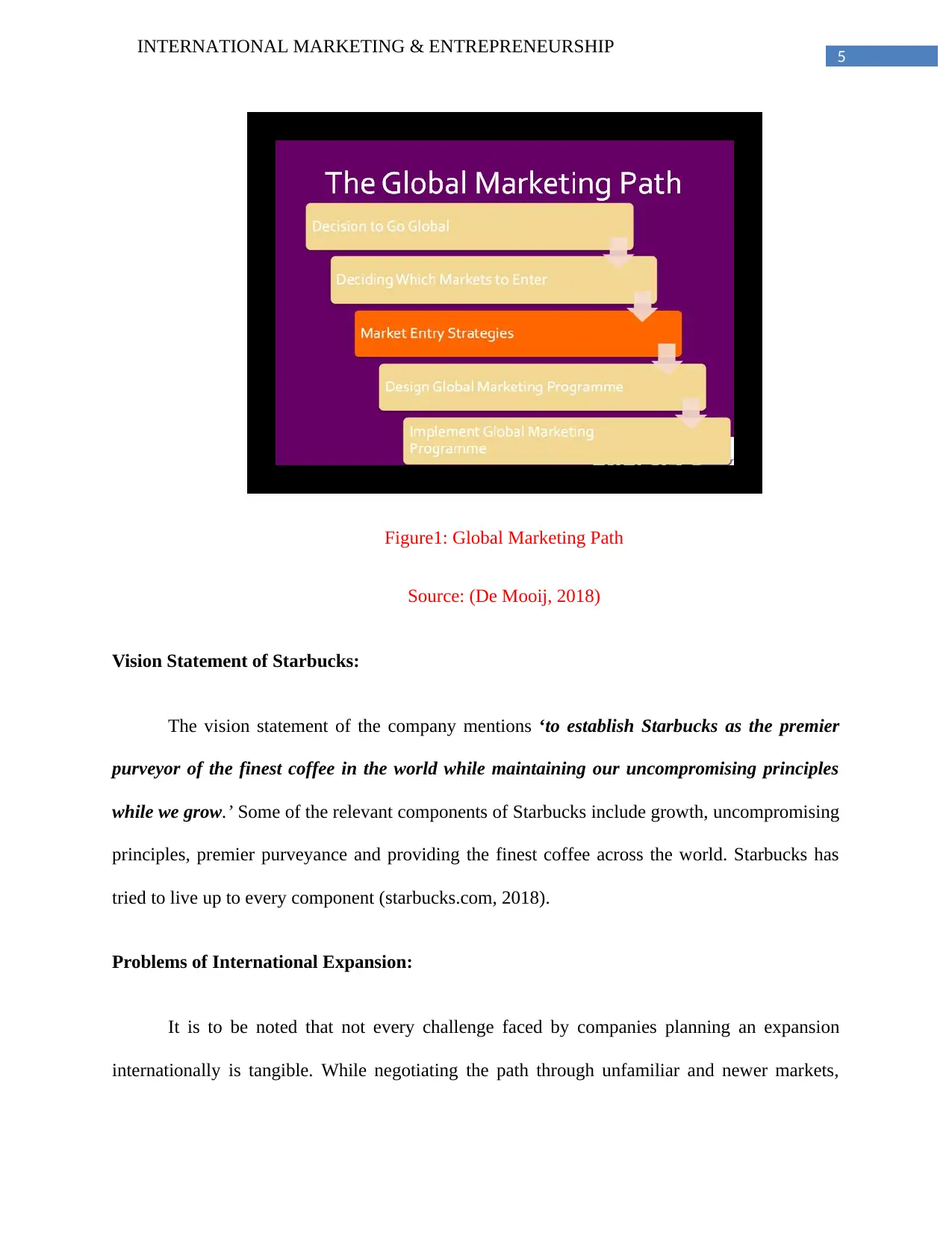
5
INTERNATIONAL MARKETING & ENTREPRENEURSHIP
Figure1: Global Marketing Path
Source: (De Mooij, 2018)
Vision Statement of Starbucks:
The vision statement of the company mentions ‘to establish Starbucks as the premier
purveyor of the finest coffee in the world while maintaining our uncompromising principles
while we grow.’ Some of the relevant components of Starbucks include growth, uncompromising
principles, premier purveyance and providing the finest coffee across the world. Starbucks has
tried to live up to every component (starbucks.com, 2018).
Problems of International Expansion:
It is to be noted that not every challenge faced by companies planning an expansion
internationally is tangible. While negotiating the path through unfamiliar and newer markets,
INTERNATIONAL MARKETING & ENTREPRENEURSHIP
Figure1: Global Marketing Path
Source: (De Mooij, 2018)
Vision Statement of Starbucks:
The vision statement of the company mentions ‘to establish Starbucks as the premier
purveyor of the finest coffee in the world while maintaining our uncompromising principles
while we grow.’ Some of the relevant components of Starbucks include growth, uncompromising
principles, premier purveyance and providing the finest coffee across the world. Starbucks has
tried to live up to every component (starbucks.com, 2018).
Problems of International Expansion:
It is to be noted that not every challenge faced by companies planning an expansion
internationally is tangible. While negotiating the path through unfamiliar and newer markets,
⊘ This is a preview!⊘
Do you want full access?
Subscribe today to unlock all pages.

Trusted by 1+ million students worldwide
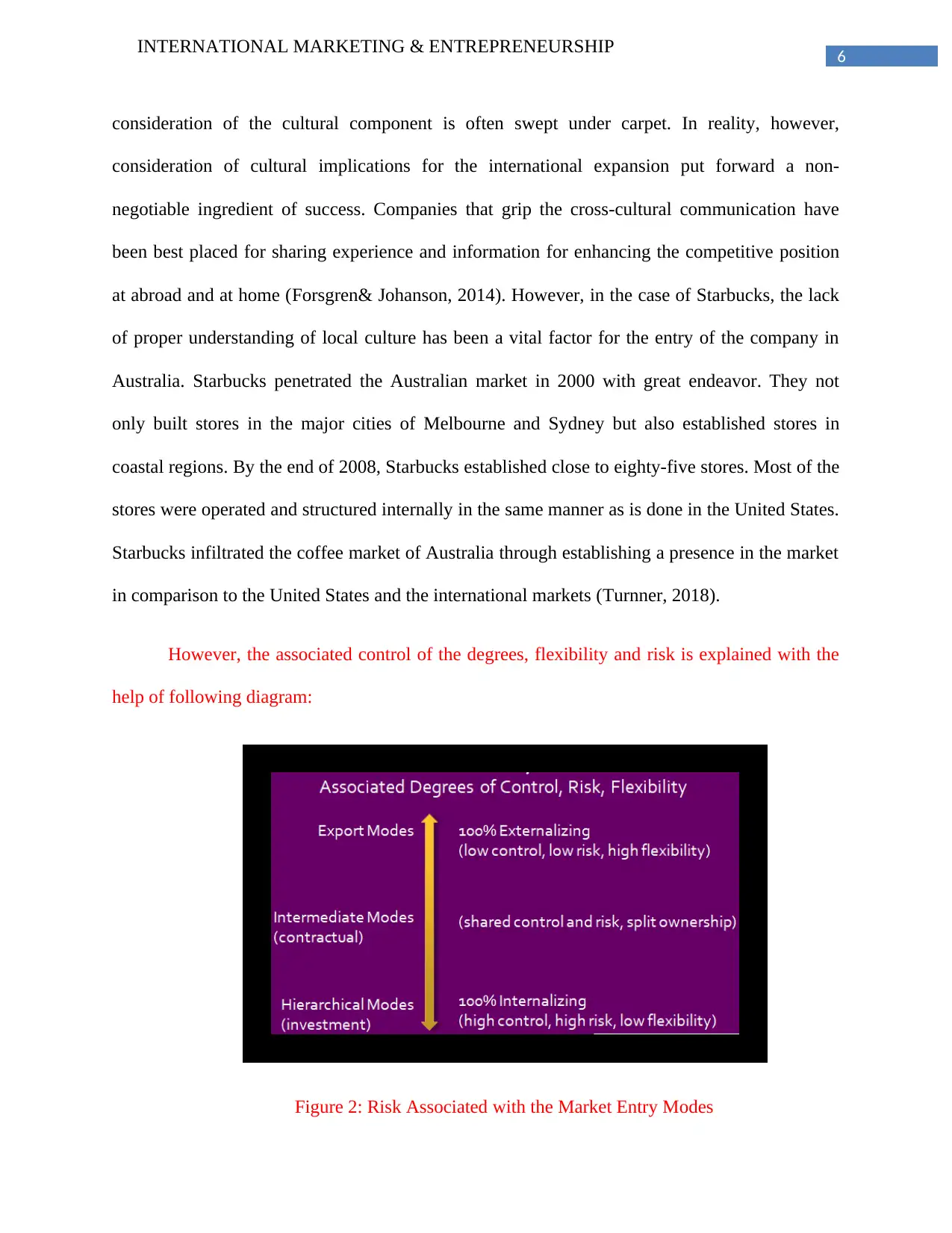
6
INTERNATIONAL MARKETING & ENTREPRENEURSHIP
consideration of the cultural component is often swept under carpet. In reality, however,
consideration of cultural implications for the international expansion put forward a non-
negotiable ingredient of success. Companies that grip the cross-cultural communication have
been best placed for sharing experience and information for enhancing the competitive position
at abroad and at home (Forsgren& Johanson, 2014). However, in the case of Starbucks, the lack
of proper understanding of local culture has been a vital factor for the entry of the company in
Australia. Starbucks penetrated the Australian market in 2000 with great endeavor. They not
only built stores in the major cities of Melbourne and Sydney but also established stores in
coastal regions. By the end of 2008, Starbucks established close to eighty-five stores. Most of the
stores were operated and structured internally in the same manner as is done in the United States.
Starbucks infiltrated the coffee market of Australia through establishing a presence in the market
in comparison to the United States and the international markets (Turnner, 2018).
However, the associated control of the degrees, flexibility and risk is explained with the
help of following diagram:
Figure 2: Risk Associated with the Market Entry Modes
INTERNATIONAL MARKETING & ENTREPRENEURSHIP
consideration of the cultural component is often swept under carpet. In reality, however,
consideration of cultural implications for the international expansion put forward a non-
negotiable ingredient of success. Companies that grip the cross-cultural communication have
been best placed for sharing experience and information for enhancing the competitive position
at abroad and at home (Forsgren& Johanson, 2014). However, in the case of Starbucks, the lack
of proper understanding of local culture has been a vital factor for the entry of the company in
Australia. Starbucks penetrated the Australian market in 2000 with great endeavor. They not
only built stores in the major cities of Melbourne and Sydney but also established stores in
coastal regions. By the end of 2008, Starbucks established close to eighty-five stores. Most of the
stores were operated and structured internally in the same manner as is done in the United States.
Starbucks infiltrated the coffee market of Australia through establishing a presence in the market
in comparison to the United States and the international markets (Turnner, 2018).
However, the associated control of the degrees, flexibility and risk is explained with the
help of following diagram:
Figure 2: Risk Associated with the Market Entry Modes
Paraphrase This Document
Need a fresh take? Get an instant paraphrase of this document with our AI Paraphraser
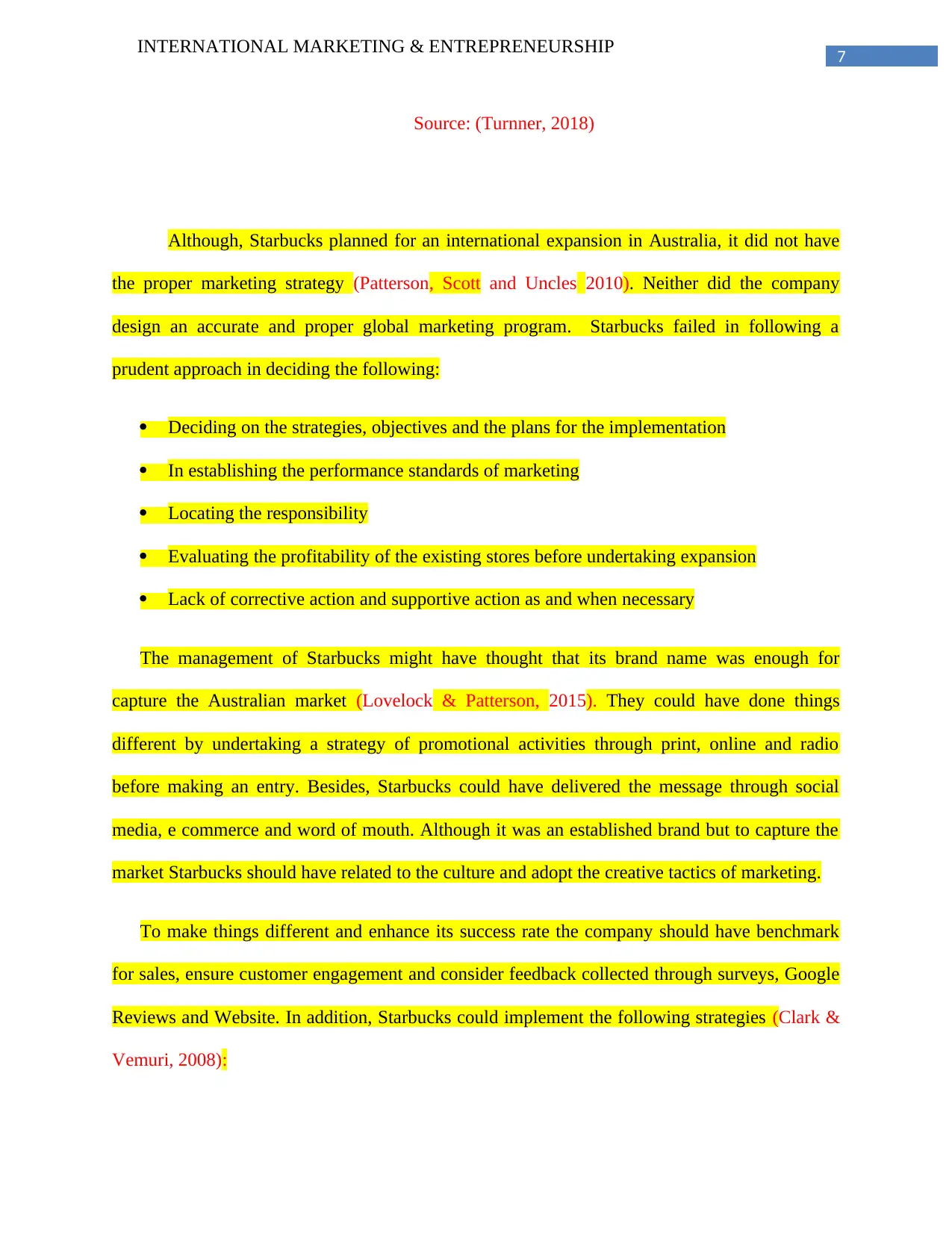
7
INTERNATIONAL MARKETING & ENTREPRENEURSHIP
Source: (Turnner, 2018)
Although, Starbucks planned for an international expansion in Australia, it did not have
the proper marketing strategy (Patterson, Scott and Uncles 2010). Neither did the company
design an accurate and proper global marketing program. Starbucks failed in following a
prudent approach in deciding the following:
Deciding on the strategies, objectives and the plans for the implementation
In establishing the performance standards of marketing
Locating the responsibility
Evaluating the profitability of the existing stores before undertaking expansion
Lack of corrective action and supportive action as and when necessary
The management of Starbucks might have thought that its brand name was enough for
capture the Australian market (Lovelock & Patterson, 2015). They could have done things
different by undertaking a strategy of promotional activities through print, online and radio
before making an entry. Besides, Starbucks could have delivered the message through social
media, e commerce and word of mouth. Although it was an established brand but to capture the
market Starbucks should have related to the culture and adopt the creative tactics of marketing.
To make things different and enhance its success rate the company should have benchmark
for sales, ensure customer engagement and consider feedback collected through surveys, Google
Reviews and Website. In addition, Starbucks could implement the following strategies (Clark &
Vemuri, 2008):
INTERNATIONAL MARKETING & ENTREPRENEURSHIP
Source: (Turnner, 2018)
Although, Starbucks planned for an international expansion in Australia, it did not have
the proper marketing strategy (Patterson, Scott and Uncles 2010). Neither did the company
design an accurate and proper global marketing program. Starbucks failed in following a
prudent approach in deciding the following:
Deciding on the strategies, objectives and the plans for the implementation
In establishing the performance standards of marketing
Locating the responsibility
Evaluating the profitability of the existing stores before undertaking expansion
Lack of corrective action and supportive action as and when necessary
The management of Starbucks might have thought that its brand name was enough for
capture the Australian market (Lovelock & Patterson, 2015). They could have done things
different by undertaking a strategy of promotional activities through print, online and radio
before making an entry. Besides, Starbucks could have delivered the message through social
media, e commerce and word of mouth. Although it was an established brand but to capture the
market Starbucks should have related to the culture and adopt the creative tactics of marketing.
To make things different and enhance its success rate the company should have benchmark
for sales, ensure customer engagement and consider feedback collected through surveys, Google
Reviews and Website. In addition, Starbucks could implement the following strategies (Clark &
Vemuri, 2008):
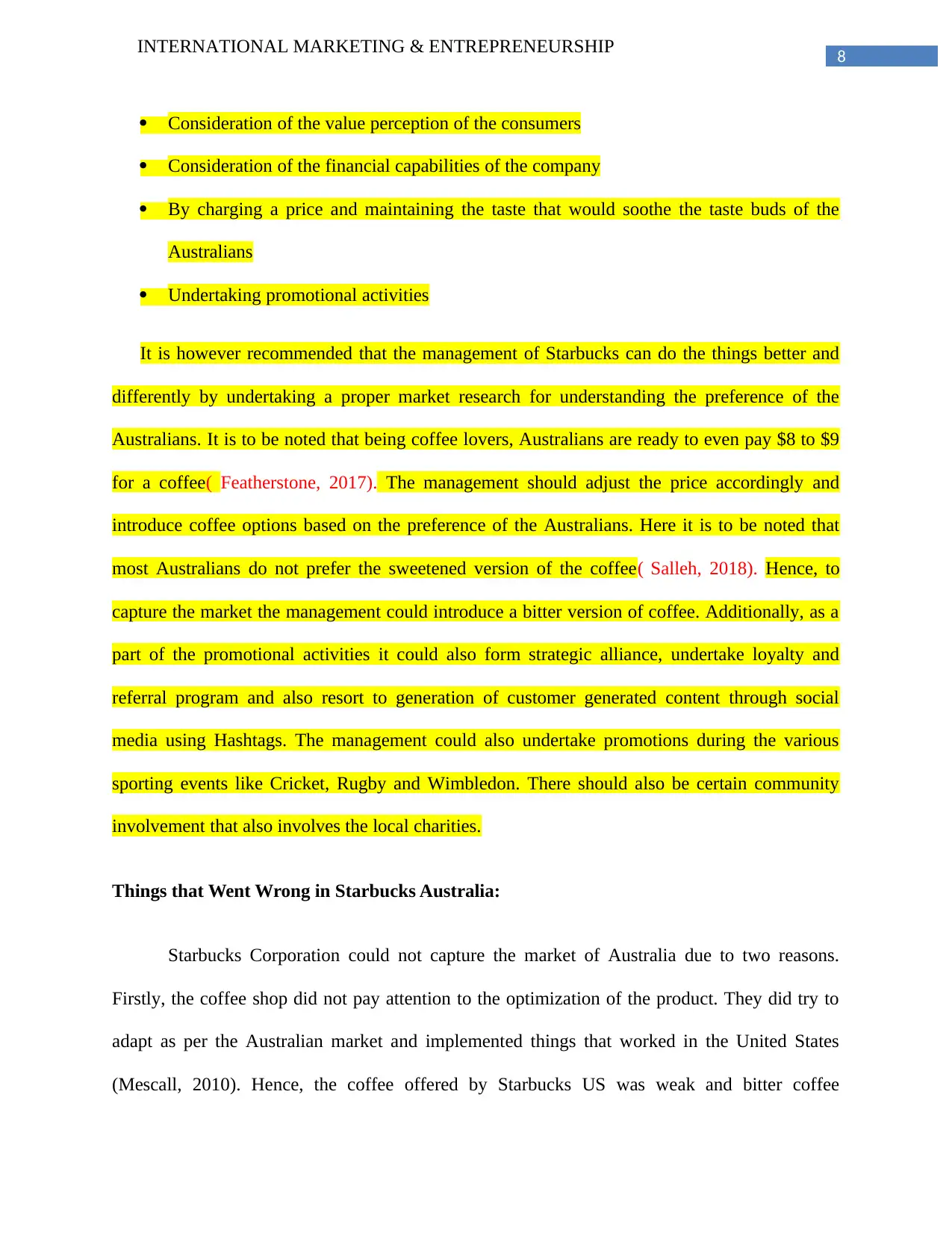
8
INTERNATIONAL MARKETING & ENTREPRENEURSHIP
Consideration of the value perception of the consumers
Consideration of the financial capabilities of the company
By charging a price and maintaining the taste that would soothe the taste buds of the
Australians
Undertaking promotional activities
It is however recommended that the management of Starbucks can do the things better and
differently by undertaking a proper market research for understanding the preference of the
Australians. It is to be noted that being coffee lovers, Australians are ready to even pay $8 to $9
for a coffee( Featherstone, 2017). The management should adjust the price accordingly and
introduce coffee options based on the preference of the Australians. Here it is to be noted that
most Australians do not prefer the sweetened version of the coffee( Salleh, 2018). Hence, to
capture the market the management could introduce a bitter version of coffee. Additionally, as a
part of the promotional activities it could also form strategic alliance, undertake loyalty and
referral program and also resort to generation of customer generated content through social
media using Hashtags. The management could also undertake promotions during the various
sporting events like Cricket, Rugby and Wimbledon. There should also be certain community
involvement that also involves the local charities.
Things that Went Wrong in Starbucks Australia:
Starbucks Corporation could not capture the market of Australia due to two reasons.
Firstly, the coffee shop did not pay attention to the optimization of the product. They did try to
adapt as per the Australian market and implemented things that worked in the United States
(Mescall, 2010). Hence, the coffee offered by Starbucks US was weak and bitter coffee
INTERNATIONAL MARKETING & ENTREPRENEURSHIP
Consideration of the value perception of the consumers
Consideration of the financial capabilities of the company
By charging a price and maintaining the taste that would soothe the taste buds of the
Australians
Undertaking promotional activities
It is however recommended that the management of Starbucks can do the things better and
differently by undertaking a proper market research for understanding the preference of the
Australians. It is to be noted that being coffee lovers, Australians are ready to even pay $8 to $9
for a coffee( Featherstone, 2017). The management should adjust the price accordingly and
introduce coffee options based on the preference of the Australians. Here it is to be noted that
most Australians do not prefer the sweetened version of the coffee( Salleh, 2018). Hence, to
capture the market the management could introduce a bitter version of coffee. Additionally, as a
part of the promotional activities it could also form strategic alliance, undertake loyalty and
referral program and also resort to generation of customer generated content through social
media using Hashtags. The management could also undertake promotions during the various
sporting events like Cricket, Rugby and Wimbledon. There should also be certain community
involvement that also involves the local charities.
Things that Went Wrong in Starbucks Australia:
Starbucks Corporation could not capture the market of Australia due to two reasons.
Firstly, the coffee shop did not pay attention to the optimization of the product. They did try to
adapt as per the Australian market and implemented things that worked in the United States
(Mescall, 2010). Hence, the coffee offered by Starbucks US was weak and bitter coffee
⊘ This is a preview!⊘
Do you want full access?
Subscribe today to unlock all pages.

Trusted by 1+ million students worldwide

9
INTERNATIONAL MARKETING & ENTREPRENEURSHIP
augmented by sweet flavors and massive quantities of milk. The sweetened hot coffee was not
well perceived by the real expresso lovers of consumers which also made it difficult to sell.
It is the wave of the Greek and Italian immigrants during the early 1950s that encouraged
Australian to adopt the art of drinking expresso as a social lubricant. Starbucks introduced to the
Americans the lighter version of the coffee shop culture of Europe while it has been a latecomer
in Australia in terms of coffee (starbucks.com.au 2019). This is because Australia had an
established espresso café culture and hence to capture the Australian market Starbucks had to
compete with the cafes that put across similar products having better or equal quality.
The second mistake that Starbucks made was a crucial and tactical error where they failed
in delivering an organic experience to an Australian consumer (sbs.com.au, 2014). While
Starbucks Corporation implemented an organic growth in America but Australia, the company
tried imposing means on the Australians. The company did so by hanging huge signs and place
an order by mentioning sizes. In other words, Starbucks tried to preach the Australians about the
ways of drinking coffee. Thus, the experience of Starbucks for the Australians has been
implanted and not organic.
Here, it is to be noted that Australians are not resistant to the phenomenon of chain coffee
stores. It is also important to note that the home-grown coffee shops were doing well since
theywere offering a coffee experience that the Australians remained comfortable with and did
not attach any weird names. In a matter of eight years, Starbucks stacked close to $143 million
loss and was forced to closing down 60 stores.
Reasons for Starbucks to not operate stores in Australia
INTERNATIONAL MARKETING & ENTREPRENEURSHIP
augmented by sweet flavors and massive quantities of milk. The sweetened hot coffee was not
well perceived by the real expresso lovers of consumers which also made it difficult to sell.
It is the wave of the Greek and Italian immigrants during the early 1950s that encouraged
Australian to adopt the art of drinking expresso as a social lubricant. Starbucks introduced to the
Americans the lighter version of the coffee shop culture of Europe while it has been a latecomer
in Australia in terms of coffee (starbucks.com.au 2019). This is because Australia had an
established espresso café culture and hence to capture the Australian market Starbucks had to
compete with the cafes that put across similar products having better or equal quality.
The second mistake that Starbucks made was a crucial and tactical error where they failed
in delivering an organic experience to an Australian consumer (sbs.com.au, 2014). While
Starbucks Corporation implemented an organic growth in America but Australia, the company
tried imposing means on the Australians. The company did so by hanging huge signs and place
an order by mentioning sizes. In other words, Starbucks tried to preach the Australians about the
ways of drinking coffee. Thus, the experience of Starbucks for the Australians has been
implanted and not organic.
Here, it is to be noted that Australians are not resistant to the phenomenon of chain coffee
stores. It is also important to note that the home-grown coffee shops were doing well since
theywere offering a coffee experience that the Australians remained comfortable with and did
not attach any weird names. In a matter of eight years, Starbucks stacked close to $143 million
loss and was forced to closing down 60 stores.
Reasons for Starbucks to not operate stores in Australia
Paraphrase This Document
Need a fresh take? Get an instant paraphrase of this document with our AI Paraphraser

10
INTERNATIONAL MARKETING & ENTREPRENEURSHIP
Starbucks store is gradually expanding in the market where it had been shunned once.
Although it is easier to locate a Starbucks store in almost every corner of the world one may face
difficulty in finding one in Australia (Mourdoukoutas, 2019). This is due to the closure of
Starbucks in almost 70 percent of the underperforming locations leaving behind only 23 stores
across the entire continent.
In spite of Australia's intense love for coffee, Starbucks could not achieve success in the
Australian continent like it did in the other countries. The coffee store was first opened in
Australia in the year 2000 and grew in close to 90 locations in the year 2008(11). The launch was
so rapid that it did not allow Australian consumers to develop an appetite for the brand. The
already existing coffee culture of Australia posed a challenge for the coffee brand of America
since its taste did not match that of Australians. Starbucks offered options for sweeter coffee
which was not preferred by the Australians and comparatively charged higher than the local
shops. In reality, Australians preferred expresso compared to flat white version
(starbucks.com.au 2019).
In the seven years that Starbucks operated in Australia, it accumulated close to $105
million in loss forcing Starbucks to pull down the shutters of sixty locations. Australia has been
the toughest market to breakthrough by Starbucks. Some of the reasons include:
Sophisticated Coffee Culture of Australia: Starbucks ignored the sophisticated coffee
culture when it established the 85 outlets of Australia. The café market of Australia is the sole
market in the country other than Italy having close to 100 percent espresso-based market across
the world (Hanson, 2016). Thus, Australians had the reputation of being consumers who have a
INTERNATIONAL MARKETING & ENTREPRENEURSHIP
Starbucks store is gradually expanding in the market where it had been shunned once.
Although it is easier to locate a Starbucks store in almost every corner of the world one may face
difficulty in finding one in Australia (Mourdoukoutas, 2019). This is due to the closure of
Starbucks in almost 70 percent of the underperforming locations leaving behind only 23 stores
across the entire continent.
In spite of Australia's intense love for coffee, Starbucks could not achieve success in the
Australian continent like it did in the other countries. The coffee store was first opened in
Australia in the year 2000 and grew in close to 90 locations in the year 2008(11). The launch was
so rapid that it did not allow Australian consumers to develop an appetite for the brand. The
already existing coffee culture of Australia posed a challenge for the coffee brand of America
since its taste did not match that of Australians. Starbucks offered options for sweeter coffee
which was not preferred by the Australians and comparatively charged higher than the local
shops. In reality, Australians preferred expresso compared to flat white version
(starbucks.com.au 2019).
In the seven years that Starbucks operated in Australia, it accumulated close to $105
million in loss forcing Starbucks to pull down the shutters of sixty locations. Australia has been
the toughest market to breakthrough by Starbucks. Some of the reasons include:
Sophisticated Coffee Culture of Australia: Starbucks ignored the sophisticated coffee
culture when it established the 85 outlets of Australia. The café market of Australia is the sole
market in the country other than Italy having close to 100 percent espresso-based market across
the world (Hanson, 2016). Thus, Australians had the reputation of being consumers who have a
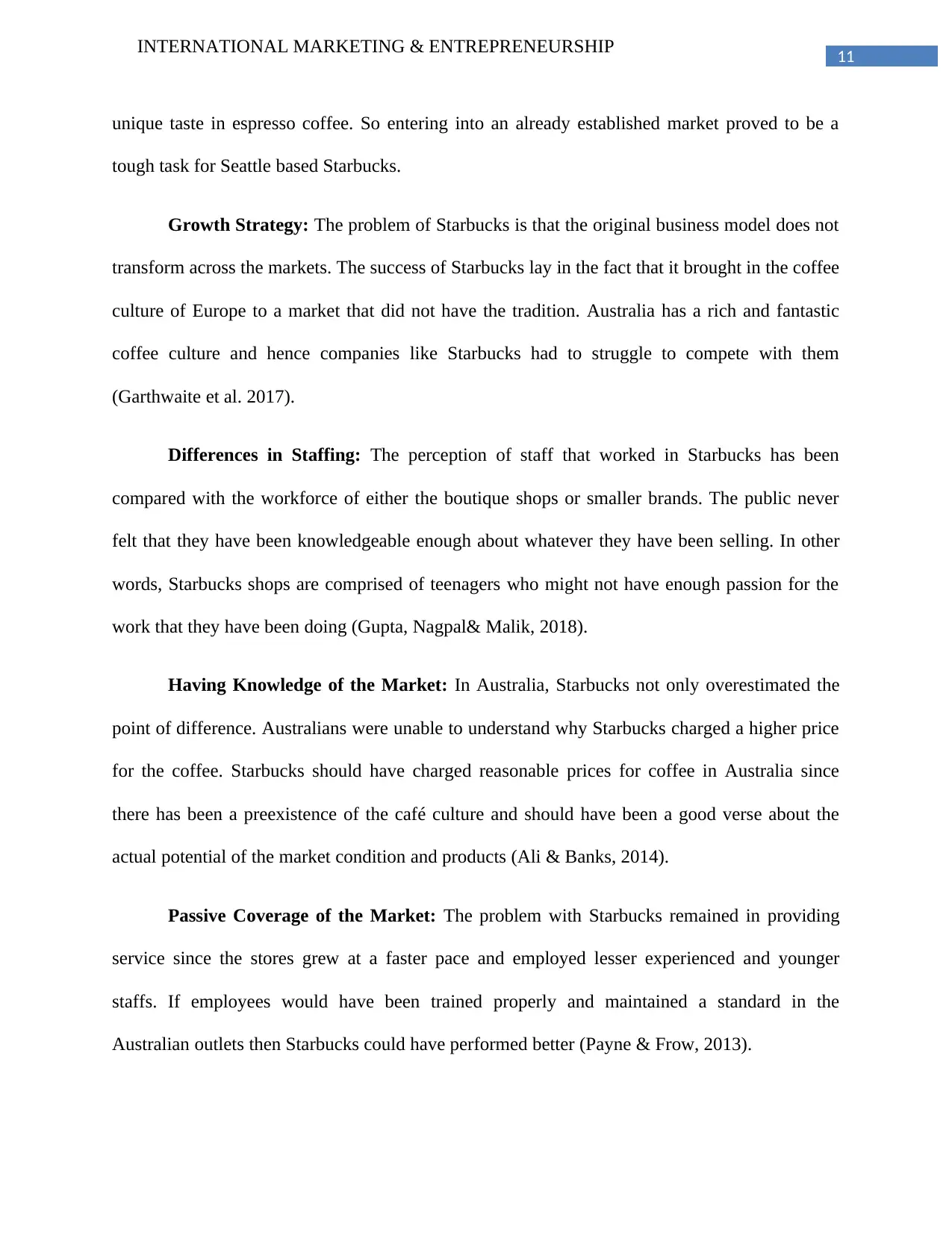
11
INTERNATIONAL MARKETING & ENTREPRENEURSHIP
unique taste in espresso coffee. So entering into an already established market proved to be a
tough task for Seattle based Starbucks.
Growth Strategy: The problem of Starbucks is that the original business model does not
transform across the markets. The success of Starbucks lay in the fact that it brought in the coffee
culture of Europe to a market that did not have the tradition. Australia has a rich and fantastic
coffee culture and hence companies like Starbucks had to struggle to compete with them
(Garthwaite et al. 2017).
Differences in Staffing: The perception of staff that worked in Starbucks has been
compared with the workforce of either the boutique shops or smaller brands. The public never
felt that they have been knowledgeable enough about whatever they have been selling. In other
words, Starbucks shops are comprised of teenagers who might not have enough passion for the
work that they have been doing (Gupta, Nagpal& Malik, 2018).
Having Knowledge of the Market: In Australia, Starbucks not only overestimated the
point of difference. Australians were unable to understand why Starbucks charged a higher price
for the coffee. Starbucks should have charged reasonable prices for coffee in Australia since
there has been a preexistence of the café culture and should have been a good verse about the
actual potential of the market condition and products (Ali & Banks, 2014).
Passive Coverage of the Market: The problem with Starbucks remained in providing
service since the stores grew at a faster pace and employed lesser experienced and younger
staffs. If employees would have been trained properly and maintained a standard in the
Australian outlets then Starbucks could have performed better (Payne & Frow, 2013).
INTERNATIONAL MARKETING & ENTREPRENEURSHIP
unique taste in espresso coffee. So entering into an already established market proved to be a
tough task for Seattle based Starbucks.
Growth Strategy: The problem of Starbucks is that the original business model does not
transform across the markets. The success of Starbucks lay in the fact that it brought in the coffee
culture of Europe to a market that did not have the tradition. Australia has a rich and fantastic
coffee culture and hence companies like Starbucks had to struggle to compete with them
(Garthwaite et al. 2017).
Differences in Staffing: The perception of staff that worked in Starbucks has been
compared with the workforce of either the boutique shops or smaller brands. The public never
felt that they have been knowledgeable enough about whatever they have been selling. In other
words, Starbucks shops are comprised of teenagers who might not have enough passion for the
work that they have been doing (Gupta, Nagpal& Malik, 2018).
Having Knowledge of the Market: In Australia, Starbucks not only overestimated the
point of difference. Australians were unable to understand why Starbucks charged a higher price
for the coffee. Starbucks should have charged reasonable prices for coffee in Australia since
there has been a preexistence of the café culture and should have been a good verse about the
actual potential of the market condition and products (Ali & Banks, 2014).
Passive Coverage of the Market: The problem with Starbucks remained in providing
service since the stores grew at a faster pace and employed lesser experienced and younger
staffs. If employees would have been trained properly and maintained a standard in the
Australian outlets then Starbucks could have performed better (Payne & Frow, 2013).
⊘ This is a preview!⊘
Do you want full access?
Subscribe today to unlock all pages.

Trusted by 1+ million students worldwide
1 out of 18
Related Documents
Your All-in-One AI-Powered Toolkit for Academic Success.
+13062052269
info@desklib.com
Available 24*7 on WhatsApp / Email
![[object Object]](/_next/static/media/star-bottom.7253800d.svg)
Unlock your academic potential
Copyright © 2020–2025 A2Z Services. All Rights Reserved. Developed and managed by ZUCOL.





